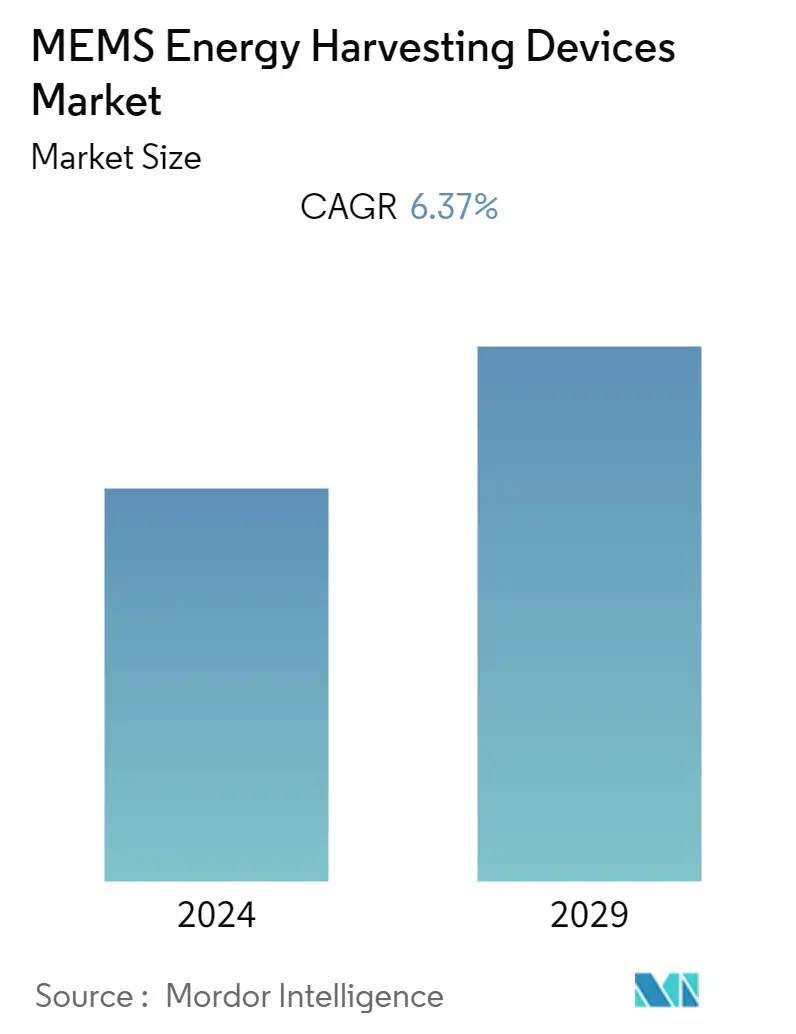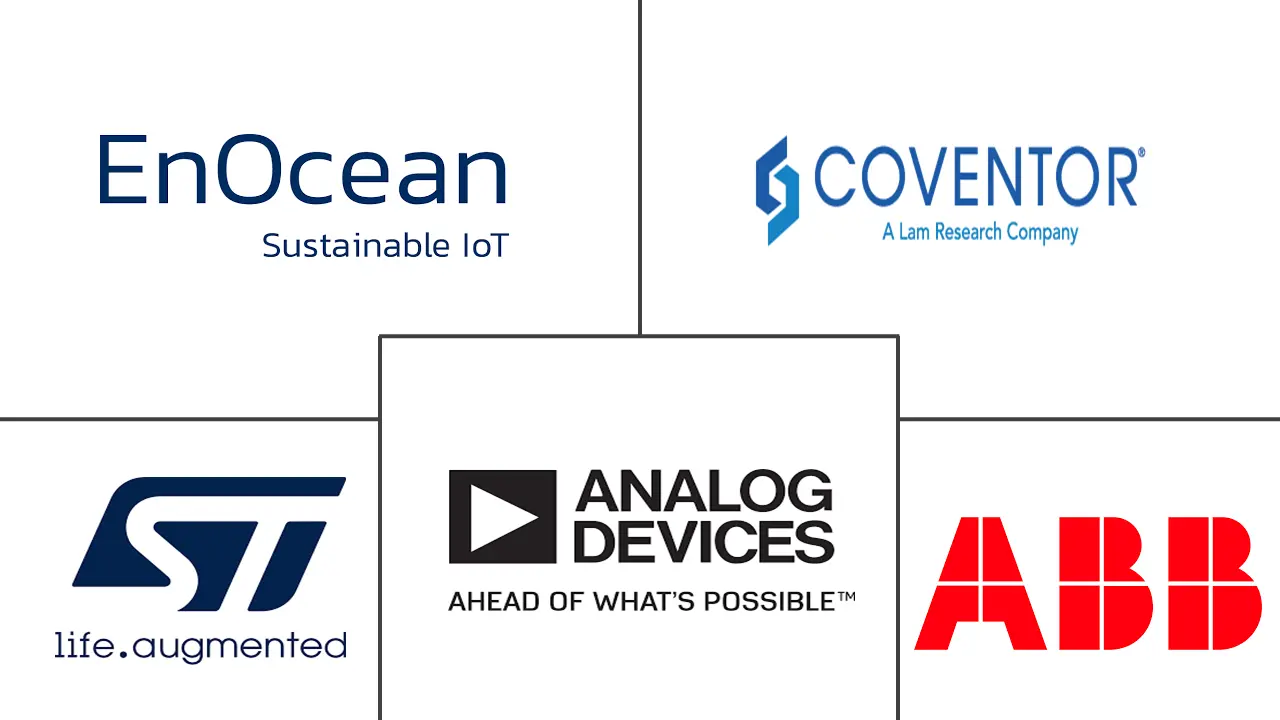Market Size of MEMS Energy Harvesting Devices Industry

| Study Period | 2019 - 2029 |
| Base Year For Estimation | 2023 |
| Forecast Data Period | 2024 - 2029 |
| CAGR | 6.37 % |
| Fastest Growing Market | Asia Pacific |
| Largest Market | Europe |
| Market Concentration | Medium |
Major Players
*Disclaimer: Major Players sorted in no particular order |
MEMS Energy Harvesting Devices Market Analysis
The MEMS energy harvesting devices market size was valued at USD 66.06 million the previous year and is expected to register a CAGR of 6.37%, reaching USD 92.62 million over the forecast period.
- Energy harvesting is used for decades for bicycle dynamos or solar panels. However, this technology is a revolution with staggering applications in building and industry automation, automotive vehicles, smart cities, and security systems. Notably, governments and favorable public initiatives are the major drivers for energy harvesting demand growth as public actors consider energy harvesting a crucial tool for meeting the increasing energy demand and saving energy. In addition, Big Data and IoT technologies led to autonomous energy-harvesting devices that require less maintenance and are easier to install than batteries.
- Moreover, the market for commercial building automation is also booming and is expected to experience significant growth with rising smart city initiatives. Energy harvesting wireless solutions find surging applications in building and home automation owing to their high cost-saving potential in installation and maintenance. Compared to copper wiring or batteries, energy-harvesting wireless technology is the ideal communication standard to interconnect thousands of building devices and find new monitoring and control applications.
- Microelectromechanical systems (MEMS) are considered the most suitable technology to realize IoT-sensing nodes. It facilitates the integrated fabrication of sensors/actuators, electronic circuits for information processing and radio frequency communication, antennas, and energy harvesters on a single chip or package. They may interact with biological, chemical, and thermal phenomena, including fluid interaction. At the same time, these devices usually interact with non-electromagnetic fields and forces, such as mechanical forces, piezoelectric and thermoelectric forces, among others. It promoted MEMS technology as an excellent tool for miniaturizing energy harvesters.
- In recent years, much development is made in energy harvesting from mechanical vibrations, thermal gradients, electromagnetic radiations, and solar radiations. This progress is made to provide alternative power sources to operate portable and personal gadgets instead of traditional batteries. As a result, the creation of ultra-low-power electronic devices became one of the main challenges likely to limit the adoption rate of MEMS-based harvesting devices.
- COVID-19 accelerated the pace towards a more patient-centric approach and increased the need for remote patient monitoring, including telehealth, point-of-care devices, and wearables. There is a growing demand for energy harvesters' wearables owing to their ability to track peoples' temperature and blood pressure. This trend created new opportunities in the wearables market, as well as for integrated MEMS sensors, such as pressure, inertial, microphones, thermopiles, etc.
MEMS Energy Harvesting Devices Industry Segmentation
MEMS energy harvesting devices capture and accumulate byproduct energy as it becomes available and then store it for some time. These devices then supply it in a form that can be used later, such as operating a microprocessor within its limits. It supports energy harvesting systems that can also be used in low-voltage and low-power applications, such as portable or mobile devices, automotive, medical, industrial machine monitoring and process control, home automation, and defense.
The MEMS energy harvesting devices market is segmented by technology (vibration energy harvesting, thermal energy harvesting, RF energy harvesting, and other types of energy harvesting), end-user applications (automotive, industrial, military and aerospace, building and home automation, consumer electronics, and other end-user applications), and geography (North America, Europe, Asia-Pacific, and rest of the world). The market sizes and forecasts are in value (USD) for all the segments.
| By Technology | |
| Vibration Energy Harvesting | |
| Thermal Energy Harvesting | |
| RF Energy Harvesting | |
| Other Types of Energy Harvesting |
| By End-user Applications | |
| Automotive | |
| Industrial | |
| Military and Aerospace | |
| Building and Home Automation | |
| Consumer Electronics | |
| Other End-user Applications |
| By Geography | |
| North America | |
| Europe | |
| Asia-Pacific | |
| Rest of the World |
MEMS Energy Harvesting Devices Market Size Summary
The MEMS energy harvesting devices market is experiencing a transformative phase, driven by advancements in technology and increasing demand for energy-efficient solutions across various sectors. This market is characterized by the integration of microelectromechanical systems (MEMS) into IoT-sensing nodes, facilitating the miniaturization of energy harvesters. The technology finds extensive applications in building and industry automation, automotive vehicles, smart cities, and security systems. The growing emphasis on energy efficiency and sustainability, coupled with government initiatives, is propelling the adoption of MEMS energy harvesting devices. These devices offer significant advantages over traditional power sources, such as batteries, by providing autonomous, low-maintenance, and easily installable solutions. The market is witnessing a surge in demand for wireless solutions in building and home automation, driven by the need for cost-effective and efficient systems.
Regionally, Asia, particularly countries like China, Japan, South Korea, and Taiwan, is at the forefront of MEMS technology development and manufacturing, supported by advanced research facilities and a robust consumer electronics market. The automotive sector is also a significant contributor to market growth, with MEMS sensors playing a crucial role in enhancing vehicle safety and efficiency. The market is relatively consolidated, with major players focusing on technological advancements and product differentiation to maintain a competitive edge. Recent innovations, such as STMicroelectronics' water/liquid-proof pressure sensor and EnOcean's energy-harvesting wireless technology, highlight the ongoing efforts to reduce carbon emissions and improve energy efficiency. The market's growth trajectory is further supported by government policies promoting clean energy technologies, creating a conducive environment for the expansion of MEMS energy harvesting devices.
MEMS Energy Harvesting Devices Market Size - Table of Contents
-
1. MARKET INSIGHTS
-
1.1 Market Overview
-
1.2 Industry Attractiveness - Porter's Five Forces Analysis
-
1.2.1 Bargaining Power of Suppliers
-
1.2.2 Bargaining Power of Buyers
-
1.2.3 Threat of New Entrants
-
1.2.4 Threat of Substitute Products
-
1.2.5 Intensity of Competitive Rivalry
-
-
1.3 Industry Value Chain Analysis
-
1.4 Impact of COVID-19 on the Market
-
-
2. MARKET SEGMENTATION
-
2.1 By Technology
-
2.1.1 Vibration Energy Harvesting
-
2.1.2 Thermal Energy Harvesting
-
2.1.3 RF Energy Harvesting
-
2.1.4 Other Types of Energy Harvesting
-
-
2.2 By End-user Applications
-
2.2.1 Automotive
-
2.2.2 Industrial
-
2.2.3 Military and Aerospace
-
2.2.4 Building and Home Automation
-
2.2.5 Consumer Electronics
-
2.2.6 Other End-user Applications
-
-
2.3 By Geography
-
2.3.1 North America
-
2.3.2 Europe
-
2.3.3 Asia-Pacific
-
2.3.4 Rest of the World
-
-
MEMS Energy Harvesting Devices Market Size FAQs
What is the current MEMS Energy Harvesting Devices Market size?
The MEMS Energy Harvesting Devices Market is projected to register a CAGR of 6.37% during the forecast period (2025-2030)
Who are the key players in MEMS Energy Harvesting Devices Market?
EnOcean Gmbh, STMicroelectronics NV, Coventor Inc. (Lam Research Corporation), Analog Devices Inc and ABB Ltd are the major companies operating in the MEMS Energy Harvesting Devices Market.

